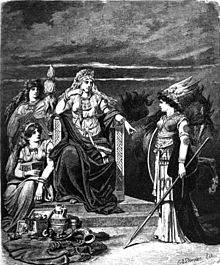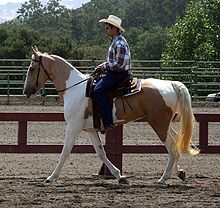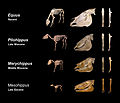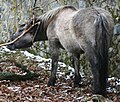The Horses PortalThe horse (Equus ferus caballus) is a domesticated, one-toed, hoofed mammal. It belongs to the taxonomic family Equidae and is one of two extant subspecies of Equus ferus. The horse has evolved over the past 45 to 55 million years from a small multi-toed creature, close to Eohippus, into the large, single-toed animal of today. Humans began domesticating horses around 4000 BCE, and their domestication is believed to have been widespread by 3000 BCE. Horses in the subspecies caballus are domesticated, although some domesticated populations live in the wild as feral horses. These feral populations are not true wild horses, which are horses that never have been domesticated and historically linked to the megafauna category of species. There is an extensive, specialized vocabulary used to describe equine-related concepts, covering everything from anatomy to life stages, size, colors, markings, breeds, locomotion, and behavior. Horses are adapted to run, allowing them to quickly escape predators, and possess a good sense of balance and a strong fight-or-flight response. Related to this need to flee from predators in the wild is an unusual trait: horses are able to sleep both standing up and lying down, with younger horses tending to sleep significantly more than adults. Female horses, called mares, carry their young for approximately 11 months and a young horse, called a foal, can stand and run shortly following birth. Most domesticated horses begin training under a saddle or in a harness between the ages of two and four. They reach full adult development by age five, and have an average lifespan of between 25 and 30 years. Horse breeds are loosely divided into three categories based on general temperament: spirited "hot bloods" with speed and endurance; "cold bloods", such as draft horses and some ponies, suitable for slow, heavy work; and "warmbloods", developed from crosses between hot bloods and cold bloods, often focusing on creating breeds for specific riding purposes, particularly in Europe. There are more than 300 breeds of horse in the world today, developed for many different uses. (Full article...) Entries here consist of Good and Featured articles, which meet a core set of high editorial standards.
 In Norse mythology, Gná (Old Norse: [ˈɡnɒː]) is a goddess who runs errands in other worlds for the goddess Frigg and rides the flying, sea-treading horse Hófvarpnir (O.N.: [ˈhoːvˌwɑrpnez̠], "he who throws his hoofs about", "hoof-thrower" or "hoof kicker"). Gná and Hófvarpnir are attested in the Prose Edda, written in the 13th century by Snorri Sturluson. Scholarly theories have been proposed about Gná as a "goddess of fullness" and as potentially cognate to Fama from Roman mythology. Hófvarpnir and the eight-legged steed Sleipnir have been cited examples of transcendent horses in Norse mythology. (Full article...) Selected image A Thoroughbred race horse at Churchill Downs. The Thoroughbred is a horse breed best known for its use in horse racing. Thoroughbreds are considered a "hot-blooded" horse, known for their agility, speed and spirit, and they have been influential in the creation of many important breeds. Latest updates
More did you know?
Related portalsEntries here consist of Good and Featured articles, which meet a core set of high editorial standards.
The Spotted Saddle Horse is a horse breed from the United States that was developed by crossing Spanish-American type gaited pinto ponies with gaited horse breeds, such as the Tennessee Walking Horse. The result was a colorful, smooth-gaited horse, used in the show ring and for pleasure and trail riding. Two registries have been created for the breed, one in 1979 and the other in 1985. The two have similar registration requirements, although one has an open stud book and the other is slightly more strict with regard to parentage requirements, having a semi-closed stud book. The Spotted Saddle Horse is a light riding horse, always pinto in color. Solid-colored foals from registered parents may be registered for identification purposes, so their pinto-colored foals have documented parentage. They always perform an ambling gait, rather than a trot, in addition to the gaits of walk and canter, performed by all breeds. (Full article...) Did you know (auto-generated)
General imagesThe following are images from various horse-related articles on Wikipedia.
TopicsHorse • Pony • Asinus • Equus (genus) • Equidae • Zebra • Glossary of equestrian terms • List of horse breeds • Evolution of the horse • Domestication of the horse • Horse care • Stable • Horse training • Equestrianism • Horse tack • Saddle • Equine nutrition • Equine anatomy • Equine conformation • Equine coat color • Equine coat color genetics • Horse markings • Equine vision • Horse hoof • Horseshoe • Horse gait • Horse behavior • Horse breeding • Breed registry • Equine infectious anemia • Horse colic • Lameness • Laminitis • Horse slaughter • Horses in warfare • Arabian horse • Thoroughbred SubcategoriesNew articlesThis list was generated from these rules. Questions and feedback are always welcome! The search is being run daily with the most recent ~14 days of results. Note: Some articles may not be relevant to this project.
Rules | Match log | Results page (for watching) | Last updated: 2024-09-29 20:12 (UTC) Note: The list display can now be customized by each user. See List display personalization for details.
WikiProjectsAssociated WikimediaThe following Wikimedia Foundation sister projects provide more on this subject:
Discover Wikipedia using portals |


























































